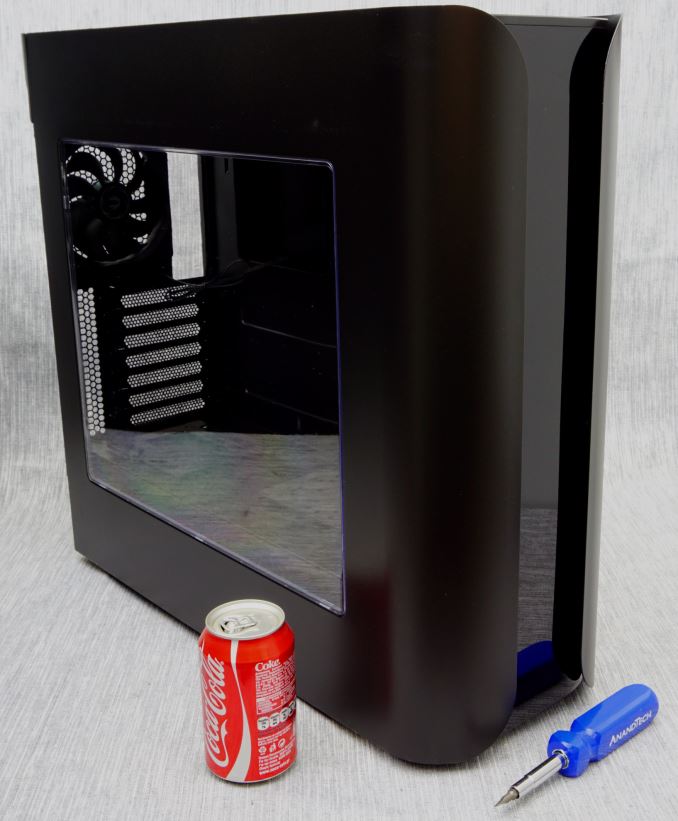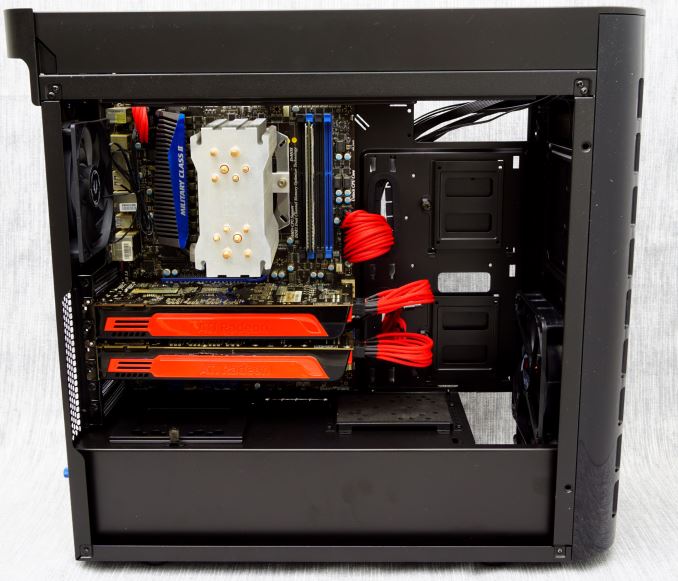The BitFenix Pandora ATX Case Review
by E. Fylladitakis on August 11, 2016 9:00 AM EST- Posted in
- Cases/Cooling/PSUs
- bitfenix
- ATX
- Case
Conclusion
Even though the Pandora ATX is aesthetically based on the original Micro-ATX version of the Pandora, any similarities between the two cases are limited to just their aesthetic design. Where the original version was meant for users who would like a beautiful case for a relatively strong but mainstream PC, the Pandora ATX is directed towards a completely different target group. The size, design, versatility and emphasis on liquid cooling support of the Pandora ATX dictate that it has been designed for users that will be installing very powerful and quite possibly overclocked hardware. The target group that the Pandora ATX is aimed to is very demanding and difficult to please. Even the smallest detail can affect the buyer’s decision and the Pandora ATX is definitely not without flaws.
The primary selling point of the Pandora ATX undoubtedly is, aesthetically speaking, its design. Aesthetics are a subjective matter but it is no secret that the original Pandora was a case loved by modders and users that would place their systems in areas that would make them visible by their friends or guests (e.g. living rooms). It is obvious that BitFenix is trying to replicate this success with the Pandora ATX for users that did not like the limitations of a Micro-ATX build. However, the size of the Pandora ATX is restrictive, as a case this size would look out of place in a simple, modern living room. On the other hand, the roomy case can house powerful hardware and advanced liquid cooling systems, making it ideal for advanced modders and liquid cooling aficionados that want to showcase their work or for large VR systems.
BitFenix tried their best to make the Pandora ATX a versatile case, easing up the work of modders and especially those that plan to install advanced liquid cooling parts. The capability to interchange the front 2.5” and 3.5” trays is interesting, as is the presence of liquid cooling tank and pump supports. The vast majority of commercial liquid cooling parts should be compatible with the Pandora ATX, from large 360 mm radiators to high pressure 12V pumps. The position of the pump mount however creates compatibility issues, as it would most likely block the installation of even a second advanced GPU. It is very strange why the designer did not place this mount down inside the PSU compartment area, where the 3.5” drive trays have been placed. This would limit the number of 3.5” drives, reducing them by at least two, but the pump would stay out of the way of the GPU cards. Those that will be installing more than one GPU will most likely be modifying the case so as to move the pump inside the bottom compartment. Finally, tanks that have been designed for installation in 5.25” device slots obviously are incompatible, as the Pandora ATX does not support 5.25” devices.
The build quality of the Pandora ATX has left us with mixed feelings. It is not uncommon to see cases with mediocre panels on a good chassis or with simple, low quality stock cooling fans installed when designers are trying to cut down the manufacturing costs. In this instance however, it seems as if the designer of the Pandora ATX worked the other way around. The front panel and plastics of the case are of excellent quality and very high quality FDB bearing cooling fans have been installed, whereas the chassis and side panels are relatively thin and weak for a case of this size. It is likely that BitFenix is using the same materials and thickness as with the original Pandora, which was significantly smaller and lighter. The result is a rather malleable chassis that could face permanent damage if mishandled with heavy hardware installed into it and side panels that are susceptible to dents, especially on the flaps extending in front of the case.
In our opinion, the greatest advantage of the Pandora ATX against the competition is its retail price. The case can be found for $112 including shipping at the time of this review, a very fair price for its size, versatility and features. There are few cases of this size at this price point where the designer emphasises on aesthetics and, at the same time, provides exceptional support for advanced liquid cooling setups. We feel that the Pandora ATX will become a favourite among enthusiasts that are building powerful, liquid cooled gaming systems and want to create an aesthetically pleasing result with relatively low effort and custom modifications.












26 Comments
View All Comments
Byte - Friday, August 12, 2016 - link
Cases with 5.25 you can always add a box, but this case you can't even do that. I just upgraded my case because it has only 2.0, got an InWin with USB 3.1 Type C in the front! Go future!Bigryan - Thursday, August 11, 2016 - link
Pretty case. I will be checking out the deals at bestbuy this weekend! The ad on the login page is the best.redfirebird15 - Saturday, August 13, 2016 - link
Literally every page... it is getting ridiculous.Nightsd01 - Thursday, August 11, 2016 - link
Can the LCD screen do anything that is actually useful? Showing a single logo....seems pretty useless to me. What about showing the stats/temps/fan speeds/etc of the computer?Lord of the Bored - Friday, August 12, 2016 - link
As I understand it, just displaying static images. You could probably rig something up that would put the desirable data into an image and then push the image to the LCD, but it's a step that ought to be unnecessary by all rights.HomeworldFound - Friday, August 12, 2016 - link
ThermalTake did the same thing about fifteen years ago. It was just as useful.BrokenCrayons - Thursday, August 11, 2016 - link
Ah yes, the Coke can makes it into yet another photo! :)It's a nice looking case, though too large for my tastes. I already have a gigantic Lian Li on wheels that has a MicroATX board, half-height capable GPU, and single hard drive inside of that looks almost laughably empty.
Samus - Thursday, August 11, 2016 - link
Ugg, I can't believe after all these years Bitfenix still hasn't improved their drive sled design. Those things are complete crap. Most of mine are cracked or completely snapped in half while bending them around the drive mount holes.althaz - Thursday, August 11, 2016 - link
As soon as I saw it, the first thing I thought was "looks a lot like the Thermaltake Armor". Because it does (nicer though).Death666Angel - Friday, August 12, 2016 - link
That's a nice, clean build. But I am totally not interested in ATX size cases anymore. :DOnly ATX case I bought in the last 7 years is for my file server which has 3x5.25" bay adapters for 5 x 3.5" HDDs (9 x 5.25" bays for 3 of those adapters for 15 3.5" bays in a normal sized ATX case). My PCs have been mATX for a while (Lian Li V351B, currently Silverstone Temjin TJ08-E with watercooling, thinking about going back to my V351B and modding the shit out of it). With me being fine with onboard sound and onboard NICs and one graphics card, there ain't no reason for ATX and the size and weight are a real negative. Only positive I see is the ample space and ease of use.